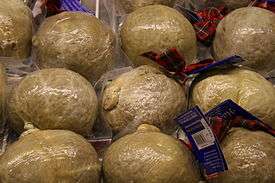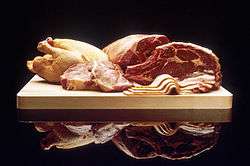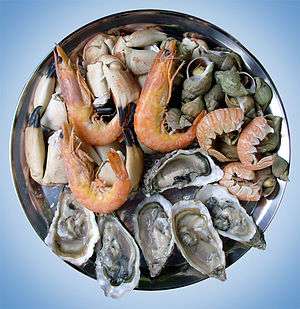Haggis
|
Haggis displayed for sale | |
| Type | Pudding |
|---|---|
| Associated national cuisine | Scotland |
| Main ingredients | Sheep's heart, liver and lungs, and stomach (or sausage casing); onion, oatmeal, suet, spices |
|
| |
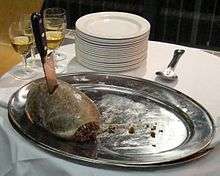

Haggis is a savoury pudding containing sheep's pluck (heart, liver and lungs); minced with onion, oatmeal, suet, spices, and salt, mixed with stock, traditionally encased in the animal's stomach[1] though now often in an artificial casing instead. According to the 2001 English edition of the Larousse Gastronomique: "Although its description is not immediately appealing, haggis has an excellent nutty texture and delicious savoury flavour".[2]
It is believed that food similar to haggis (though not so named), perishable offal quickly cooked inside an animal's stomach, all conveniently available after a hunt, was eaten from ancient times.[3][4][5]
Although the name "hagws" or "hagese" was first used in England c. 1430, the dish came to be considered traditionally Scottish, even the national dish,[6] as a result of Scots poet Robert Burns' poem Address to a Haggis of 1787. Haggis is traditionally served with "neeps and tatties", boiled and mashed separately, and a dram (a glass of Scotch whisky), especially as the main course of a Burns supper.
History and etymology
Haggis is popularly assumed to be of Scottish origin,[1] but there is a lack of historical evidence that could conclusively attribute its origins to any one place. The first known written recipes for a dish of the name made with offal and herbs, are, as "hagese", in the verse cookbook Liber Cure Cocorum dating from around 1430 in Lancashire, North West England,[7] and, as "hagws of a schepe"[8] from an English cookbook also of c. 1430.
- For hagese'.
- Þe hert of schepe, þe nere þou take,
- Þo bowel noght þou shalle forsake,
- On þe turbilen made, and boyled wele,
- Hacke alle togeder with gode persole,
The Scottish poem Flyting of Dunbar and Kennedy, which is dated before 1520 (the generally accepted date prior to the death of William Dunbar, one of the composers), refers to 'haggeis'.[9]
Thy fowll front had, and he that Bartilmo flaid;The gallowis gaipis eftir thy graceles gruntill,
As thow wald for ane haggeis, hungry gled.
— William Dunbar, Flyting of Dunbar and Kennedy
An early printed recipe for haggis appears in 1615 in “The English Huswife” by Gervase Markham. It contains a section entitled “Skill in Oate meale”.[10]
The use and vertues of these two severall kinds of Oate-meales in maintaining the Family, they are so many (according to the many customes of many Nations) that it is almost impossible to recken all;” and then proceeds to give a description of “oat-meale mixed with blood, and the Liver of either Sheepe, Calfe or Swine, maketh that pudding which is called the Haggas or Haggus, of whose goodnesse it is in vaine to boast, because there is hardly to be found a man that doth not affect them— Gervase Markham, The English Huswife
Food writer Alan Davidson suggests that the Ancient Romans were the first known to have made products of the haggis type.[3] Even earlier, a kind of primitive haggis is referred to in Homer's Odyssey, in book 20, (towards the end of the eighth century BC) when Odysseus is compared to "a man before a great blazing fire turning swiftly this way and that a stomach full of fat and blood, very eager to have it roasted quickly." Haggis was "born of necessity, as a way to utilize the least expensive cuts of meat and the innards as well."[4]
Clarissa Dickson Wright says that it "came to Scotland in a longship [i.e., from Scandinavia] even before Scotland was a single nation."[11] She cites etymologist Walter William Skeat as further suggestion of possible Scandinavian origins: Skeat claimed that the hag– element of the word is derived from the Old Norse haggw or the Old Icelandic hoggva[12] (höggva in modern Icelandic[13]), Modern Scots hag, meaning 'to hew' or strike with a sharp weapon, relating to the chopped-up contents of the dish.
Dickson Wright suggests that haggis was invented as a way of cooking quick-spoiling offal near the site of a hunt, without the need to carry along an additional cooking vessel. The liver and kidneys could be grilled directly over a fire, but this treatment was unsuitable for the stomach, intestines, or lungs. Chopping up the lungs and stuffing the stomach with them and whatever fillers might have been on hand, then boiling the assembly—probably in a vessel made from the animal's hide—was one way to make sure these parts were not wasted.[5]
Folklore
In the absence of hard facts as to haggis' origins, popular folklore has provided some notions. One is that the dish originates from the days of the old Scottish cattle drovers. When the men left the Highlands to drive their cattle to market in Edinburgh the women would prepare rations for them to eat during the long journey down through the glens. They used the ingredients that were most readily available in their homes and conveniently packaged them in a sheep's stomach allowing for easy transportation during the journey. Other speculations have been based on Scottish slaughtering practices. When a chieftain or laird required an animal to be slaughtered for meat (whether sheep or cattle) the workmen were allowed to keep the offal as their share.
A joke sometimes maintained is that a haggis is a small Scottish animal with longer legs on one side, so that it can run around the steep hills of the Scottish Highlands without falling over. According to one poll, 33% of American visitors to Scotland believed haggis to be an animal.[14]
Modern use
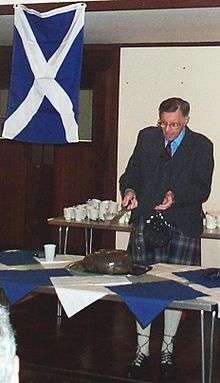

Haggis is traditionally served as part of the Burns supper on or near January 25, the birthday of Scotland's national poet Robert Burns. Burns wrote the poem Address to a Haggis, which starts "Fair fa' your honest, sonsie face, Great chieftain o' the puddin-race!" In Burns's lifetime haggis was a common dish of the poor as it was nourishing yet very cheap, being made from leftover parts of sheep otherwise thrown away.
Haggis is widely available in supermarkets in Scotland all year, with cheaper brands normally packed in artificial casings, rather than stomachs. Sometimes haggis is sold in tins or a container which can be cooked in a microwave or conventional oven. Some commercial haggis is largely made from pig, rather than sheep, offal.[15] Kosher haggis, not only pork-free but fully conformant to Jewish dietary laws, is produced.[16]
Haggis is often served in Scottish fast-food establishments, in the shape of a large sausage[17][18][19] and deep fried in batter. Together with chips, this comprises a "haggis supper".[18][19] A "haggis burger" is a patty of fried haggis served on a bun. A "haggis pakora" is another deep fried variant, available in some Indian restaurants in Scotland. Haggis can be used as an ingredient in other dishes, even pizza, rather than the main part of a dish.[20][21][22]
A traditional haggis recipe describes haggis as "sheep's 'pluck' (heart, liver and lungs), minced with onion, oatmeal, suet, spices, and salt, mixed with stock, and traditionally encased in the animals stomach and boiled". Ingredients are sheep stomach, heart and lungs of one lamb, onions, oatmeal, salt, pepper, stock, and water, with optional ingredients dried coriander, cinnamon, and nutmeg. It can be boiled, baked, or deep fried.[23]
Vegetarian haggis
Since the 1960s various Scottish shops and manufacturers have made what they call vegetarian haggis, substituting various pulses, nuts and vegetables for the meat. There are also recipes for home made vegetarian haggis. Oats and barley may be included as may different types of lentils, split peas, aduki beans, kidney beans, borlotti beans, peanuts, other nuts and mushrooms, onions and carrots.[24]
Drinks
Scotch whisky is often said to be the traditional accompaniment for haggis, though this may simply be because both are traditionally served at a Burns supper.
Haggis company MacSween conducted a taste-test[25] which indicated that whisky is a proper accompaniment, and adds that lighter-bodied, tannic red wines, such as those made from the Barbera grape, are also suitable, as are strong, powerfully flavoured British ales.
Outside Scotland
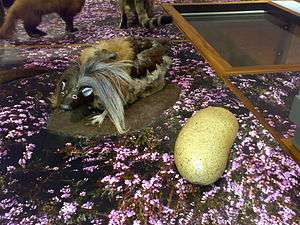
Haggis remains popular with expatriate Scots in the United States, Canada, Australia, and New Zealand, owing to the strong influence of Scottish culture, especially for Burns Suppers. It can easily be made in any country, but is sometimes imported from Scotland. A recipe from the Canadian province of New Brunswick uses pork and bakes it in a loaf pan.
In 1971 it became illegal to import haggis into the US from the UK due to a ban on food containing sheep lung, which constitutes 10 to 15% of the traditional recipe.[26] The situation was further complicated in 1989 when all UK beef and lamb was banned from importation to the US due to a BSE crisis.[26] In 2010 a spokeswoman for the US Department of Agriculture stated that they were reviewing the ban on beef and lamb products, but that the ban on food containing sheep lung would remain in force.[26]
As haggis cannot be exported to the United States, it is instead made there, sometimes by Scottish companies. One such uses what is stated to be the same 150-year-old recipe and ingredients as in Scotland, except that sheep lung is not used, and the casing is always artificial.[27]
Trivia
Haggis is used in a sport called haggis hurling, which involves throwing a haggis as far as possible. The world record for haggis hurling was achieved by Lorne Coltart on 11 June 2011, who hurled his haggis 217 ft (66 m). This throw surpassed the longstanding previous record of 180 ft 10 in (55.12 m), held by Alan Pettigrew since 1984.[28][29]
On October 8, 2008, competitive eater Eric "Steakbellie" Livingston set a world record by consuming 3 lb (1.4 kg) of haggis in 8 minutes on WMMR radio in Philadelphia.[30]
Following his victory in The Masters golf tournament in 1988, Scottish golfer Sandy Lyle served haggis at the annual Champions Dinner before the 1989 Masters.[31]
During the Korean War, the Argyll and Sutherland Highlanders received 180 pounds (82 kg) of haggis from the No. 30 Transport Unit RAAF during "Operation Haggis".[32]
Lorne Coltart (UK) from Perthshire in Scotland threw a haggis 66m (217 ft) at the Bearsden & Milngaive Highland Games, Scotland, UK, on11th June 2011. [33]
See also
References
- Notes
- 1 2 "haggis". Oxford English Dictionary (3rd ed.). Oxford University Press. September 2005. (Subscription or UK public library membership required.) First recorded as "hagws" "Now considered specially Scottish, but a popular dish in [early] English cookery"
- ↑ Montagné, Prosper (2001). Larousse Gastronomique. p. 592.
- 1 2 Davidson, Alan (2006). The Oxford Companion to Food. UK: Oxford University Press. ISBN 0-19-280681-5.
- 1 2 Andrew Zimmern
- 1 2 Dickson Wright, Clarissa (1998). The Haggis: A Little History. Pelican Publishing Company. ISBN 1-56554-364-5.
- ↑ "Food and Drink in Scotland – Scottish Cuisine". Scotland.org.
- ↑ "Liber cure Cocorum – A Modern English Translation with Notes, Based on Richard Morris' transcription of 1862.".
- ↑ "Corpus of Middle English Prose and Verse".
- ↑ Dunbar, William; Harriet Harvey Wood (2003). William Dunbar: Selected Poems. Routledge. p. 18. ISBN 0-415-96943-3.
- ↑ Markham, Gervase (1631). The English House-wife, Containing the Inward and Outward Vertues Which Ought to Be in a Compleate Woman (4th Edition). John Harison. p. 240.
- ↑ Barham, Andrea (2005). The Pedant's Revolt: Why Most Things You Think Are Right Are Wrong. Michael O'Mara Books Ltd. ISBN 1-84317-132-5.
- ↑ The Concise Oxford Dictionary of English Etymology, 1996. Retrieved on 29 June 2009
- ↑ An Icelandic-English Dictionary, Page 309, Richard Cleasby, Guðbrandur Vigfússon, George Webbe Dasent – 1874
- ↑ "American tourists believe Haggis is an animal", guardian.co.uk, 2003-11-27.
- ↑ "Traditional Ball Haggis (1kg)".
- ↑ "The Jewish Chronicle ePaper".
- ↑ "A guide to haggis". BBC Good Food.
chip shop-friendly haggis sausages specially shaped for deep-frying
- 1 2 "Scottish Miscellany: Everything You Always Wanted to Know About Scotland the ... - Jonathan Green - Google Books". Books.google.co.uk. 2013-12-13. Retrieved 2016-04-20.
A popular chip-shop dish throughout Scotland is the haggis supper, which is a long haggis pudding, shaped like a sausage, served with french fries. Some...serve the traditional large round haggis puddings though these tend to be too large for most appetities and some find them too spicy.
- 1 2 Ian Irvine (25 January 2013). "You don't have to be Scottish to enjoy haggis". The Independent.
the haggis supper – haggis in the form of a substantial sausage coated in batter and deep-fried till crisp
- ↑ Herald Scotland: Braised Beef Cheeks with Haggis Crumble. An example of the use of haggis as an ingredient
- ↑ "Macsween – Recipes".
- ↑ Ranscombe, Peter (2012-01-22). "Scots sell focaccia to Italy – and haggis pizzas to Burns revellers". Scotland on Sunday.
- ↑ "Haggis recipe & ingredients".
- ↑ The Guardian (London) 22.01.2015 How to cook the perfect vegetarian haggis
- ↑ "Drinks with haggis". Retrieved 2009-05-29.
- 1 2 3 "US not ready to lift ban on Scottish haggis". BBC News. 2010-01-26. Retrieved 2011-01-19.
- ↑ "Frequently Asked Question's".
- ↑ "Lorne is haggis world record-breaker". Milngavie Herald(Scotland). Retrieved October 2, 2012.
- ↑ "Haggis in Sport". Retrieved 2012-10-02.
- ↑ "International Federation of Competitive Eating". IFOCE. 2008-10-08. Retrieved 2009-05-25.
- ↑ The Course. The Official Site of the Masters Tournament. Retrieved on 2007-01-08.
- ↑ No. 36 Squadron (1950–66). "Operations Record Book". National Archives of Australia: 210.
- ↑ Glenday, Craig (2013). Guinness Book G|of Records 2014. p. 220. ISBN 9781908843159.
External links
| Look up haggis in Wiktionary, the free dictionary. |
| Wikimedia Commons has media related to Haggis. |
| Wikibooks Cookbook has a recipe/module on |
| Wikisource has original text related to this article: |
- Alton Brown's Haggis Recipe
- Belief in the Wild Haggis
- How to cook the perfect Burns supper at scotland.org
- Haggis, Hail to Thee!- slideshow by Life magazine
- HAGGIS at The Foods Of England
- Address to a Haggis in French on YouTube
